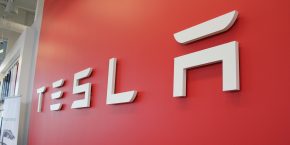

My skin crawls every time the press calls the Porsche Mission E a “Tesla Killer”, which is often. Of course, it could simply be attributed to “clickbaiting” since they rarely if ever base the statement on facts, but the notion is especially ridiculous because if anything, the Mission E actually validates Tesla’s lead.
Porsche recently green-lighted the all-electric 4-door sedan for production with a $700 million investment to expand and to add electric motors manufacturing to its capacity. The company aims to bring the car to market by the “end of the decade”. Tesla launched the Model S in 2012, making the Mission E about 8 years late for its mission to “kill” the Tesla Model S.
Now what is Porsche bringing to the market 8 years late?
I will not compare the designs, both vehicles are luxury 4-door sedans, that’s good enough. I’ll focus on the electric drivetrain.
The company says it is aiming for the Mission E to have “over 310 miles of range” (500 km) on a single charge. Being based in Germany, Porsche is likely basing the estimate on the New European Driving Cycle (NEDC), which is much more forgiving than the EPA rating. The Tesla Model S 85D has a range of 328 NEDC-rated miles (528 km).
Automakers have yet to bring to production a battery pack anything close to Tesla’s 85 kWh pack, which it brought to market in 2012, and Porsche says it is aiming for a pack of similar size by the end of the decade.
As for performance, Porsche didn’t reveal much information, but the company confirmed aiming for 0 to 60 mph in 3.5 seconds. This is a really good time, but still behind the performance versions of the Model S, which can accelerate from 0 to 60 mph in 3.1 seconds to 2.8 seconds depending on the package.
The only point on which the Mission E seems to compete with the Model S is on fast-charging. Again, the company didn’t reveal much information about its fast-charging capacity, but it claims the Mission E will be able to charge up to 80% in about 15 minutes. Depending on the Supercharger and the Model S battery pack, Tesla can charge to 80% in about 30 minutes.
It would truly be impressive if Porsche really delivers on this feature, but at the same time, we have to keep in mind that Tesla has been improving on the Supercharger infrastructure since its launch in 2012 and there’s no telling what it will be able to do by the end of decade when Porsche will have the Mission E. Also, having the technology is one thing, but the company will also have to develop the network of chargers.
Tesla will be hard to catch with a lead of 576 Supercharger stations with 3,321 Supercharger stalls around the world.
Even if Porsche delivers perfectly on everything it claims, which is not often the case with concept vehicles, it would still be about 6 to 8 years late to be anything close to a “Tesla Killer”. I welcome Porsche entry in the all-electric vehicle field, but lets put the “Tesla killer” thing to rest.
FTC: We use income earning auto affiliate links. More.





80% in 15 minutes for pack size similar to Tesla’s would need around 250-300kW charging speed. Current Combo/CHAdeMO has 50kW. There is nooooo way Porsche could achieve this. But I would be the first in line to congratulate them if they can.
Also, 8 years late and shorter range is pitiful…
Generally it seems that all EV’s that isn’t a Model S, are “Tesla killers”, they aren’t going to kill anything until they are actually available for sale and they are not. It’s silly. Tesla aren’t standing still either. They have offered a 90kWh battery for some time now and who knows when they will offer a 100kWh or more?
The only areas where i could see weaknesses in Tesla’s Model S is Interior/Exterior (since porsche is a premium brand with years of experience in said areas) and sustainability. I say sustainability because i read repords that claim that teslas batterypack “works” around 9,5 years, where as batterypacks of the BMW i3 can “work” for around 20 years. Thing is that these critics are based on simulations and we can only see if there will be a future wave of tesla model s that stop working as promised. Anyway i think that by the time given tesla can make the improvements needed. As Elon Musk states that there will be improvements in the batterypacks after the launch of the gigafactory.
Some Model S owners already have over 120k miles. After those miles om i3 what range will be left?
Tesla use expensive battreries(panasonic) with high energy density 265Wh/kg. Model S has battery pack with energy density – 156Wh/kg. BMW i3 battery pack(samsung sdi) has energy density – 95Wh/kg. How much will weight BMW sedan(not plastic like i3) like Model S with 85kWh Samsung battery? Around 6000 lbs.
If you check Envia batteries with 400Wh/kg they have high energy density but short lifespan and slow charging. No any battery have highest energy density, longest lifespan and fastest charge/discharge rate.
Just imagine the wire to connect the electric car to the chatging station ; 600 A at 400 V dc or 500 A at 600 Vcc
this is heavy industrial welding machine cables … the connectors will have to be pure silver 1 inch pins
you would have to hire a strong man or a robotic charging machine to use this equipment …
it is more theorical laboratory achivement for record breaking or publicity purpose .
Excellent point
They can use 2 cables. Som buses already charge like that. That’s not the problem. But now they can’t have battery with high energy density and high charging rate. They will use low energy density batteries which can handle higher charging rate and this battery pack will take more space in the car. And then Porsche Mossion E will be havier than Model S. And if we see Missoin E for sale the car will cost over $300 000.
I still question why there is a cable and plug at all. Why not put the contacts on the bottom of the car so when you pull into a supercharger parking space, the charging connector itself rises from the ground to connect ? This way you can have a completely solid copper bar carrying all that electricity instead of a cable which must be light enough and flexible enough to be handled by a human.
That’s a very good point – Tesla said they could charge at higher rates even today, but the main challenge was getting higher rate transformers installed (the comment was non-specific beyond that).
I think what Porsche may be aiming for here is a different battery chemistry, like solid state batteries, or silicon-based anodes, or perhaps one of a dozen other recent inventions currently in lab testing phases.
Just some correction:
Since it’s just a concept study, Porsche hasn’t published exact specification about power and acceleration. They just claimed that the acceleration will be < 3.5s (less than) to 100 km/h (62 mph) not to 60 mph, which is < 3.3 sec to 60 mph. The 0-200 km/h (0-124 mph) will be 440 kW (more than) (> 600 hp), the torque will be > 900 Nm, the top speed will be > 250 km/h and the range will be more than 500 km. Have a look at Porshce’s website. And thanks to the “dieselgate”, the NEDC will be replaced to a more strict system ’til 2017. The Porsche also claimed that it will be able to achieve this range even with sporty driving and with no power loss on race tracks. They want to make it an “under 8 minutes” car on Nürburgring Nordschleife. It can easily achieve the specs above in normal conditions but I’m a bit skeptic with the “sporty driving” claim.
The 15 mins fast charge would be a good selling point, but there is no charging station that is capable of deliver this power on 800V. But if Tesla could build it’s own charging network, it shouldn’t be a problem for Porsche. They have the money for that and actually the firm has already isolated €1B for this project.
Anyway… I was thinking about the battery, range and basically the technology behind it in general. This car looks very sleek and since it has some aerodynamic improvement (such as mirror-less design, “flow-through” body like BMW i8 and active spoiler on the back), it’s able to achieve the Model S’s 0.24 drag coefficient (or very close to that). But this car’s height is only 1300 mm vs 1435 mm of Model S. That leads to a much less air drag. The car’s weight has to be a couple of hundreds kg less as well, since it has a smaller (flatter) body and beside aluminum they want to use carbon fiber for the life modul (and maybe for the rims). Summarizing these things we get a significantly less power demand for both acceleration and progress. So they can use a smaller battery and they will because if you have a look at the structural images of the car, you can see there are two big cut outs on the battery tray right under rear passenger seats. This results in an other weight loss BTW. And I don’t think they chose an 800V system just because of fast charging. There’s a small chance – i think that – this has some other advantages, like better efficiency. But it’s just pure guessing, don’t take it seriously!
So in my opinion it’s gonna be a very interesting car! And will it beat the Model S in sales? Definitely not! Probably it will be a bit more expensive. (Not sure because of the possibly smaller battery.) In terms of utility the Model S is way more practical for large families. The Mission E is just a 4 seater vs. the Model S’s 5+2. It may have a slightly smaller cargo capacity, and since it’s a flat sport sedan, it may be difficult to get in and out over age of 50. But for youth and smaller families it’s gonna be very stylish alternative against Modes S. And it will probably rip off a piece from the sales of Model S. Not that much in the US, but definitely more in EU.
Just some correction:
Since it’s just a concept study, Porsche hasn’t published exact specification about power and acceleration. They just claimed that the acceleration will be < 3.5s (less than) to 100 km/h (62 mph) not to 60 mph, which is 600 hp), the torque will be > 900 Nm, the top speed will be > 250 km/h and the range will be more than 500 km. Have a look at Porshce’s website. And thanks to the “dieselgate”, the NEDC will be replaced to a more strict system ’til 2017. The Porsche also claimed that it will be able to achieve this range even with sporty driving and with no power loss on race tracks. They want to make it an “under 8 minutes” car on Nürburgring Nordschleife. It can easily achieve the specs above in normal conditions but I’m a bit skeptic with the ���sporty driving” claim.
The 15 mins fast charge would be a good selling point, but there is no charging station that is capable of deliver this power on 800V. But if Tesla could build it’s own charging network, it shouldn’t be a problem for Porsche. They have the money for that and actually the firm has already isolated €1B for this project.
Anyway… I was thinking about the battery, range and basically the technology behind it in general. This car looks very sleek and since it has some aerodynamic improvement (such as mirror-less design, “flow-through” body like BMW i8 and active spoiler on the back), it’s able to achieve the Model S’s 0.24 drag coefficient (or very close to that). But this car’s height is only 1300 mm vs 1435 mm of Model S. That leads to a much less air drag. The car’s weight has to be a couple of hundreds kg less as well, since it has a smaller (flatter) body and beside aluminum they want to use carbon fiber for the life modul (and maybe for the rims). Summarizing these things we get a significantly less power demand for both acceleration and progress. So they can use a smaller battery and they will because if you have a look at the structural images of the car, you can see there are two big cut outs on the battery tray right under rear passenger seats. This results in an other weight loss BTW. And I don’t think they chose an 800V system just because of fast charging. There’s a small chance – i think that – this has some other advantages, like better efficiency. But it’s just pure guessing, don’t take it seriously!
So in my opinion it’s gonna be a very interesting car! And will it beat the Model S in sales? Definitely not! Probably it will be a bit more expensive. (Not sure because of the possibly smaller battery.) In terms of utility the Model S is way more practical for large families. The Mission E is just a 4 seater vs. the Model S’s 5+2. It may have a slightly smaller cargo capacity, and since it’s a flat sport sedan, it may be difficult to get in and out over age of 50. But for youth and smaller families it’s gonna be very stylish alternative against Modes S. And it will probably rip off a piece from the sales of Model S. Not that much in the US, but definitely more in EU.
Something went wrong while I edited my my comment. The second sentence should be: “They just claimed that the acceleration will be < 3.5s (less than) to 100 km/h (62 mph) not to 60 mph, which is about 600 hp (more than), the torque will be > 900 Nm, the top speed will be > 250 km/h and the range will be more than 500 km.”
Agreed!